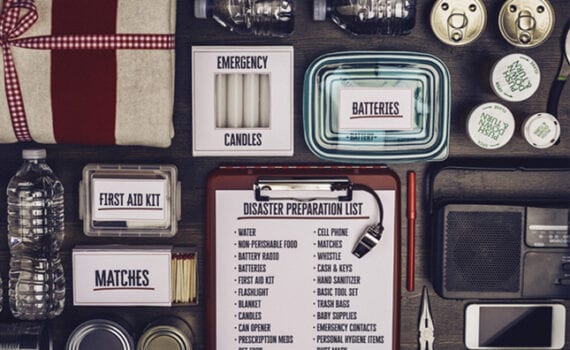
Build a Pet Disaster Survival Kit
By Carol Kendig
May 8th is National Animal Disaster Preparedness Day
Floods! Fires! Earthquakes! Snowbound! Hurricanes! Ice Storms! Any one of these can leave you with no electricity, no water, no communication, and roads that are impassable. You are trapped, alone with your pet depending 100% on you, their fearless leader, to take care of their needs. Can you both survive or will you be a sad casualty of the latest disaster? Building a Pet Disaster Survival Kit is the best first step.
None of us want to think about natural or human-caused disasters, but they seem to be happening more frequently in our increasingly fragile eco-system. Don’t lay awake nights worrying about “what ifs?” Get proactive! Create emergency disaster kits for yourself and your pets. As Benjamin Franklin so wisely said, “An ounce of prevention is worth a pound of cure.”
Pet Disaster Survival Kit Content Ideas
- Food and water for at least five days. One gallon of water per day for dogs. Larger dogs may need more, and if your dog is small any extra water can be used for cleanliness.
- Bowls and some treats.
- First aid kit with extra pet meds stored in watertight container.
- Bags to collect and store pet waste.
- ID collar on pet and an extra collar and leash.
- Carrier to transport and/or contain pet.
- Blanket and toy for comfort.
- A whistle.
Pet Disaster Kit Documentation
Those are the basics, but some experts advise adding a current photo of you with your pet to help people identify your pet and your ownership, written instructions about your pet’s special needs plus veterinarian information, grooming essentials such as a dry shampoo and brush and paper towels and plastic trash bags always come in handy. If you have a cat you will want to add a litter box, litter and scoop.
Purchase or Make at Home?
You can purchase Pet Disaster Survival Kits, but it’s fairly simple to create your own using items with which your pets are familiar. I keep an abbreviated kit in my car, just in case my dog and I are on the road when something unexpected happens. Loose items are stored in a flexible sport bag and stashed under the seat and water jugs are in the trunk. My main survival kits are in the basement at home, cached under the stairs with jugs of water put aside in three or four other places.
One friend recommends putting as much survival gear as you can in a human backpack and another in a dog’s backpack and leaving them near a door, easy to grab and dash out if necessary. A third friend keeps his pet’s kit in a sport bag beside his bed. Accessibility and portability are key for an effective kit.
Healthy Food, Long Shelf-Life
Northwest Naturals raw freeze-dried foods and treats are a useful addition to your pet disaster survival kits. Freeze dried for a long shelf life and high palatability these familiar foods can give comfort to frightened upset pets. They are also lightweight and clean and easy to feed. If you feed canned food be sure and include a can opener. Kibble will be heavy and needs to be monitored for freshness. Remember to check your kit yearly to make sure everything is up to date.
Disaster survival kits are like insurance; we hope we never have to use it but feel safer knowing we have the protection. I don’t know about you, but if the zombie apocalypse comes staggering through my neighborhood, my pets and I are going to grab our survival kits and head for the hills. Hope you can do the same!
Resources:
- NWN Freeze-Dried Dog Food.
- NWN Freeze-Dried Cat Food.
- Freeze-Dried Treats for Cats & Dogs.
- Red Cross Pet Disaster Preparedness
Written by: Carol Kendig, Northwest Naturals